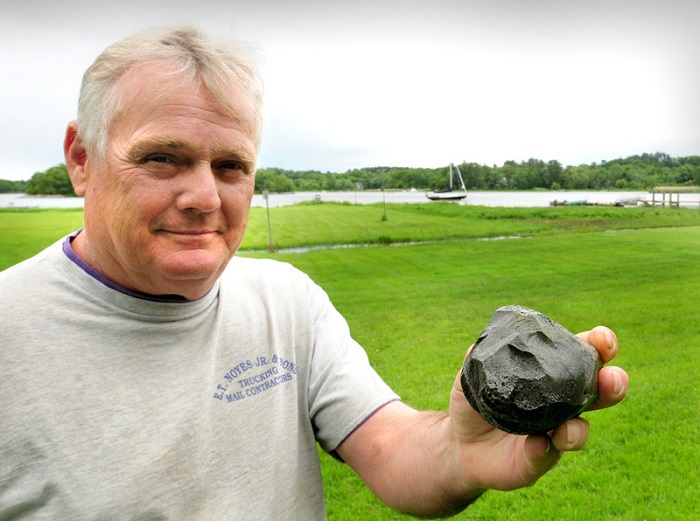.

.
NASA: Amesbury rock came from Soviet spacecraft
AMESBURY — Phil Green knew he’d found something unusual when he pulled the strange green rock out of the Merrimack River six years ago, but it wasn’t until recently that he found out his discovery was truly out of this world.
Green, a custodian at the Amesbury Elementary School who lives by the Merrimack River, recently received confirmation from NASA that a strange rock he found is actually a piece of the Mir Space Station that fell into his backyard.
The space agency confirmed the rock’s origin after a year-long analysis, and sent the rock and a plaque back to Green for him to keep a couple of weeks ago.
Green said he found the rock while searching for arrowheads down by the river near his house, and said it stuck out to him immediately when he saw it.
“The river gets scoured really well by the ice in the wintertime, so you wouldn’t expect to find a small rock sitting on top of what’s almost like pavement and granite,” Green said. “So I went over and picked it up.”
The rock was covered in mud, but when he washed it off he found that it had a burnt shade of green and looked as if someone had tried to chip away at it. It had a distinctive glassy structure too, except for one side also had about a hundred tiny pores, the kind frequently found in volcanic rock.
Green checked it with his metal detector and found that it had no traces of metal in it. Perplexed, he decided to leave the rock outside on top of another rock by his house, and that’s where it remained for another five years.
“I kind of lost track of it,” Green said. “I didn’t really think much of it, and then a fellow came over, saw it and said that’s a meteor.”
Green didn’t think it could be because it wasn’t metallic, but he ended up bringing it inside and cleaning it up anyway. Not long later, his sister-in-law, a Newburyport teacher, came over for a visit, saw the rock and took it, sending it to NASA to be analyzed.
A year went by, and eventually Green assumed the strange rock was gone for good, until a couple of weeks ago when he received a package in the mail from NASA containing his rock, a plaque and a letter from NASA Analysis Engineer George Leussis confirming that the rock had indeed fallen from space.
“It’s funny that the week I got it back, I happened to wake up and think to myself ‘I wonder what happened to my rock, I don’t think I’m ever going to see it again,’” Green said. “And then it came back.”
The letter confirmed that while the rock originated on Earth, it had definitely been subjected to a fall from low Earth orbit, which was the reason for the rock’s green color and strange properties.
“The material shows a composition similar to that used as ballast by the soviet space program starting in the mid 1980s,” Leussis wrote. “This places its most likely origin as Mir, or one of the Progress-M class Russian resupply vehicles, that had undergone a TPS failure.”
Mir was a Russian space station that operated in low Earth orbit from 1986 to 2001, and at one point it held the record for the longest uninterrupted human presence in space and the distinction of being the largest artificial satellite orbiting the Earth. The International Space Station has since surpassed both records.
Mir fell to earth in March 2001, with the bulk of it landing in the South Pacific ocean. It’s unclear how a piece of it could have fallen so far from the bulk of the spacecraft.
Although it’s impossible to speculate what the rock originally looked like before it was subjected to the intense heat and pressure of reentry, NASA was able to conclude that the rock is not radioactive, and thus safe to handle and appreciate in its new form.
When he found out the rock had fallen from space, Green said he wasn’t totally surprised, given that the reason he noticed it in the first place was because it was somewhere on the riverbank it shouldn’t have been.
“It had to [have fallen], there’s no other way,” Green said. “There was a big flat rock and this thing was just sitting there, and with the dynamics of the river there’s no way that could’ve happened, unless [he whistled and made a falling gesture with his hand].”
Quelle: Eagle Tribune
